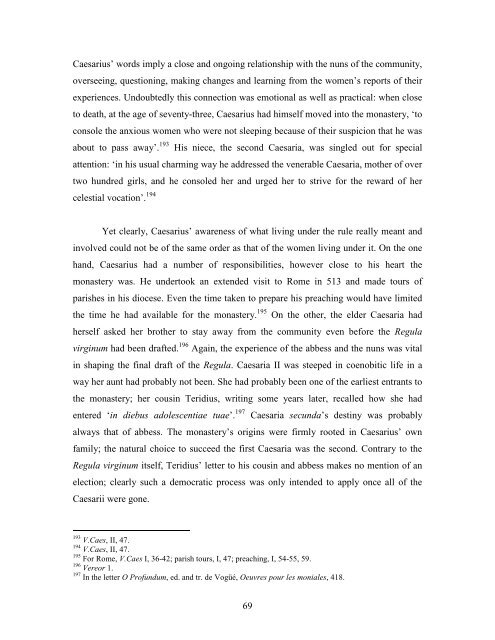Lindsay Rudge PhD Thesis - University of St Andrews
Lindsay Rudge PhD Thesis - University of St Andrews
Lindsay Rudge PhD Thesis - University of St Andrews
Create successful ePaper yourself
Turn your PDF publications into a flip-book with our unique Google optimized e-Paper software.
Caesarius’ words imply a close and ongoing relationship with the nuns <strong>of</strong> the community,<br />
overseeing, questioning, making changes and learning from the women’s reports <strong>of</strong> their<br />
experiences. Undoubtedly this connection was emotional as well as practical: when close<br />
to death, at the age <strong>of</strong> seventy-three, Caesarius had himself moved into the monastery, ‘to<br />
console the anxious women who were not sleeping because <strong>of</strong> their suspicion that he was<br />
about to pass away’. 193 His niece, the second Caesaria, was singled out for special<br />
attention: ‘in his usual charming way he addressed the venerable Caesaria, mother <strong>of</strong> over<br />
two hundred girls, and he consoled her and urged her to strive for the reward <strong>of</strong> her<br />
celestial vocation’. 194<br />
Yet clearly, Caesarius’ awareness <strong>of</strong> what living under the rule really meant and<br />
involved could not be <strong>of</strong> the same order as that <strong>of</strong> the women living under it. On the one<br />
hand, Caesarius had a number <strong>of</strong> responsibilities, however close to his heart the<br />
monastery was. He undertook an extended visit to Rome in 513 and made tours <strong>of</strong><br />
parishes in his diocese. Even the time taken to prepare his preaching would have limited<br />
the time he had available for the monastery. 195 On the other, the elder Caesaria had<br />
herself asked her brother to stay away from the community even before the Regula<br />
virginum had been drafted. 196 Again, the experience <strong>of</strong> the abbess and the nuns was vital<br />
in shaping the final draft <strong>of</strong> the Regula. Caesaria II was steeped in coenobitic life in a<br />
way her aunt had probably not been. She had probably been one <strong>of</strong> the earliest entrants to<br />
the monastery; her cousin Teridius, writing some years later, recalled how she had<br />
entered ‘in diebus adolescentiae tuae’. 197 Caesaria secunda’s destiny was probably<br />
always that <strong>of</strong> abbess. The monastery’s origins were firmly rooted in Caesarius’ own<br />
family; the natural choice to succeed the first Caesaria was the second. Contrary to the<br />
Regula virginum itself, Teridius’ letter to his cousin and abbess makes no mention <strong>of</strong> an<br />
election; clearly such a democratic process was only intended to apply once all <strong>of</strong> the<br />
Caesarii were gone.<br />
193<br />
V.Caes, II, 47.<br />
194<br />
V.Caes, II, 47.<br />
195<br />
For Rome, V.Caes I, 36-42; parish tours, I, 47; preaching, I, 54-55, 59.<br />
196<br />
Vereor 1.<br />
197<br />
In the letter O Pr<strong>of</strong>undum, ed. and tr. de Vogüé, Oeuvres pour les moniales, 418.<br />
69

















